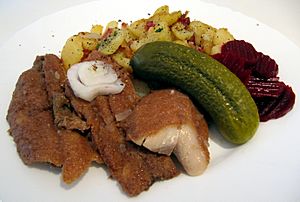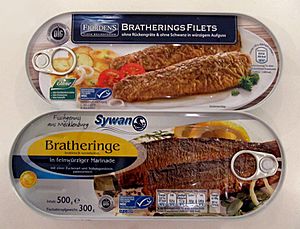Brathering facts for kids

Brathering (pronounced "braht-heh-ring") is a classic and simple German dish. It means "fried herring" in English. This tasty meal is made from herring fish that is first fried and then soaked in a special liquid called a marinade.
Brathering is very popular in northern Germany and parts of the Netherlands. People often enjoy it for lunch or as a quick snack. You can find it at fast food stands or restaurants that offer take-out.
Contents
How Brathering is Made

To make Brathering, fresh herring fish are used. First, their heads and insides are removed. Then, the fish are either coated in bread crumbs or simply dusted with flour. After that, they are fried until they are golden brown.
The next important step is to pickle the fried fish. This means soaking them in a special marinade. This marinade is made from white vinegar, water, onion slices, salt, and different spices. Common spices include black pepper, bay leaves, mustard seeds, and a little sugar.
The marinade does something clever: it helps to soften the tiny bones in the herring. This makes the fish much easier and more enjoyable to eat.
Keeping Brathering Fresh
If you keep Brathering in the refrigerator, it can stay good for up to two weeks. You can also buy Brathering already made and packed in cans at supermarkets.
How to Eat Brathering
Brathering is usually served cold, after it has soaked up all the flavors from the marinade. It often comes with warm fried potatoes (called Bratkartoffeln) or a cold potato salad (called Kartoffelsalat).
Sometimes, you can also find Brathering served in a sandwich. These fish sandwiches are known as Fischbrötchen and are a popular snack, especially near the coast.
Brathering in History
A famous person from history, Martin Luther, once said that Brathering was one of his favorite dishes. He liked to eat it with cooked green peas and mustard. This combination is not common today, but it shows how long Brathering has been a part of German food traditions!
See also
 In Spanish: Brathering para niños
In Spanish: Brathering para niños

